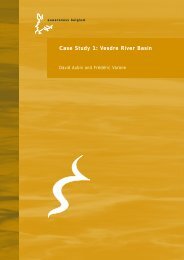Case Study 1: Matarraña River Basin - Euwareness
Case Study 1: Matarraña River Basin - Euwareness
Case Study 1: Matarraña River Basin - Euwareness
Create successful ePaper yourself
Turn your PDF publications into a flip-book with our unique Google optimized e-Paper software.
and the Central Government.<br />
Apart from that, in 1995 the Central Government adopted a decree approving urgent<br />
measures against draught. The decree included the construction of a hydraulic system<br />
pumping project water from the <strong>Matarraña</strong> river to the Pena dam.<br />
The Ministry of Environment, created in 1996, is the department holding responsibilities<br />
on water policy. The inter-regional river basin administrations —in this case the Ebro<br />
Hydrographic Confederation— depend on it.<br />
The Confederación Hidrográfica del Ebro (CHE)<br />
The CHE is the Ebro river basin agency. It was created in 1926 and currently depends<br />
on the Ministry of Environment. It is the main actor in the regulative system of the<br />
<strong>Matarraña</strong> river basin. Its functions include: the adoption of the Ebro river hydrological<br />
plan (the <strong>Matarraña</strong> river is tributary to the Ebro river), done in 1998; the promotion of<br />
regulation projects (for instance, the system pumping project water from the <strong>Matarraña</strong><br />
to the Pena dam in Beceite); the ordering of the watering out of the Pena dam; the<br />
fixation of the ecological flow (now it is 325 l/second); the granting for the concessions<br />
for irrigation and other water uses; the granting for waste disposal authorisations; and<br />
the control of activities in the river basin through the so-called water commissaries<br />
(Comisarios de aguas).<br />
While the CHE plays a key position in the regulation system: it has many political and<br />
legal resources available and has adopted a hierarchical and marked top-down<br />
approach to regulation. It has traditionally has promoted regulation projects based on<br />
the construction of large infrastructures that have proved be technically inefficient: the<br />
Pena water dam (1930), the tube for deviating water (1970s), the pumping project<br />
(1995-98) and the failed wells project at the head of the river basin (1998). In most<br />
cases (except for the latter), the implementation of these projects have raised intense<br />
conflict among the different interests of the river basin level. These regulation<br />
infrastructures have traditionally generated opposition by the municipalities located at<br />
the head of the river basin (mainly Beceite and Valderrobres), but have had adepts at<br />
the middle and lower river basin (Maella, Fabara and Nonaspe). In addition, by the<br />
creation of infrastructures, the CHE has given new water concessions, partly as a<br />
means to finance the works, and has contributed to create increasing water demands.<br />
32



